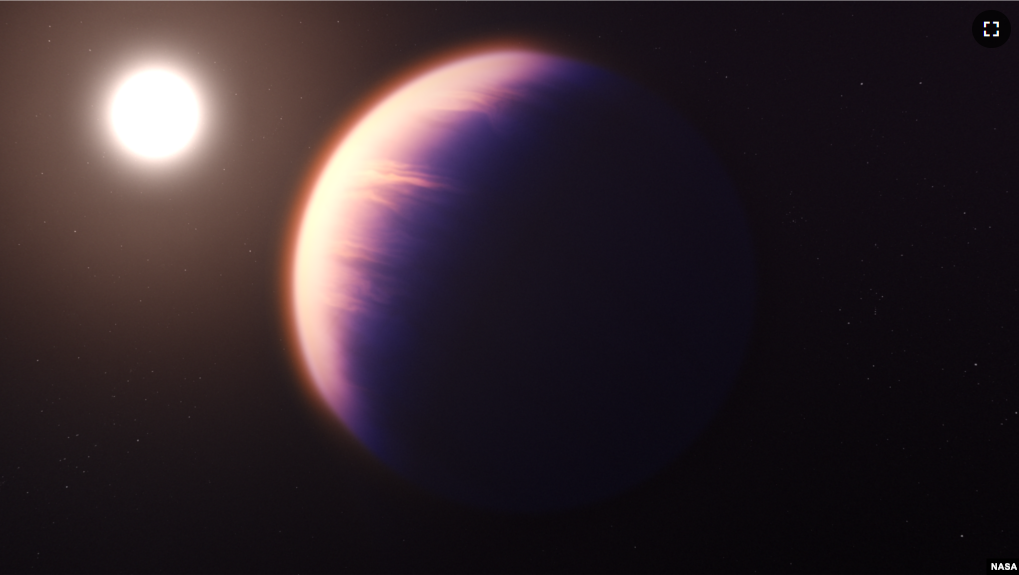The newly deployed James Webb Space Telescope has discovered the first clear evidence of carbon dioxide in the atmosphere of a planet outside our solar system.
The American space agency NASA confirmed the evidence, which it said was discovered in the atmosphere of a planet orbiting a star about 700 light years from Earth. Planets that orbit a star outside our solar system are called exoplanets.
NASA said the exoplanet where the carbon dioxide was found, or detected, is a hot, gas planet. It was discovered in 2011 and is called WASP-39 b. The exoplanet – which has a mass about the same as Saturn’s – stays around 900 degrees Celsius. It remains hot because it orbits very close to its star.
The space agency said the Hubble and Spitzer space telescopes have made observations of WASP-39 b in the past. Those observations suggested the presence of water vapor, sodium and potassium in the exoplanet’s atmosphere.
But now, the presence of carbon dioxide has also been confirmed in its atmosphere. NASA said the Webb telescope was able to make the discovery because of its unusual technical abilities.
Researchers recently described the discovery in a paper published online. A detailed study about the findings is to appear in an upcoming issue of the publication Nature.
NASA has described Webb as “the largest and most powerful space science telescope ever built.” It is a joint partnership between NASA, the European Space Agency (ESA) and the Canadian Space Agency.
Webb is designed to gather more data and explore parts of space that have never been observed before. In July, NASA released the first images captured by the Webb telescope. The images demonstrated Webb’s ability to collect data on distant objects and observe highly detailed elements of galaxies and exoplanets.
NASA said a sensitive, infrared instrument made it possible for the orbiting observatory to confirm the presence of carbon dioxide in WASP-39 b’s atmosphere. The instrument is called a Near-Infrared Spectrograph (NIRSpec).
NIRSpec is designed to capture radiation in near-infrared wavelengths. Using this instrument, astronomers are able to produce a detailed map of some of the chemicals found in a planet’s atmosphere, if conditions are right. This permits scientists to look for the presence of gasses and other substances.
Zafar Rustamkulov is a student at Johns Hopkins University and a member of the Webb’s Early Release Science team. He said in a statement that as soon as he saw the carbon dioxide data, he knew it was a major discovery. “It was a special moment, crossing an important threshold in exoplanet sciences.”
Natalie Batalha of the University of California at Santa Cruz helped lead the team. She said, “Detecting such a clear signal of carbon dioxide on WASP-39 b bodes well for the detection of atmospheres on smaller, terrestrial-sized planets.”
NASA said such discoveries are important because they help scientists better understand the makeup of a planet’s atmosphere. This can provide valuable information about how planets formed and developed over time.
“Carbon dioxide molecules are sensitive tracers of the story of planet formation,” said Mike Line of Arizona State University. He is another member of the research team. “By measuring this carbon dioxide…, we can determine how much solid versus how much gaseous material was used to form this gas giant planet.”
Line added that in coming years, the Webb telescope is expected to continue making similar discoveries. In doing so, scientists can gain “insight into the details of how planets form and the uniqueness of our own solar system.”
I’m Bryan Lynn.
Bryan Lynn wrote this story for VOA Learning English, based on reports from NASA, Agence France-Presse and the Max Planck Institute for Astronomy.
Quiz – NASA Finds Evidence of Carbon Dioxide in Exoplanet Atmosphere

Start the Quiz to find out
________________________________________________________________
Words in This Story
vapor – n. small drops of liquid that exist in the air
threshold – n. the level at which something starts to happen
bode well – n. to be a good sign for the future
terrestrial – adj. of or relating to Earth
trace – v. to follow something
insight – n. the ability to understand what something is really like
unique – adj. different from other things
